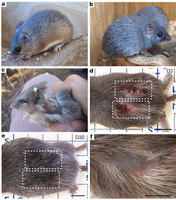The regenerated tail of a lizard is not a perfect replica of the original, but a poor knick-off with a different anatomy. This finding raises the question of whether it will ever be possible to fully regenerate injured human limbs – despite optimistic claims to the contrary.
Rebecca Fisher of the University of Arizona College of Medicine in Phoenix and her colleagues discovered key anatomical differences when they looked at original and fully regenerated tails in the green anole lizard (Anolis carolinensis), which can “drop” its tail when caught by a predator and later grow another. Running through the new tail, for example, was a single tube of cartilage rather than the hain link of vertebrae found in the original.
The muscles were different too. In place of shorter, variegated muscle fibres were long muscles stretching from tip to stump.
Both differences suggest the regenerated tail would be less flexible, says Fisher, because neither cartilage tube nor the long muscle fibres are capable of the fine control that comes with shorter muscles and lots of small joints between the bones. Further functional studies should show what changes these might make to the lizard’s agility.
Most intriguing to Fisher were the pores she noticed throughout the cartilage. A tail made of vertebrae has regular gaps that allow blood vessels and nerves to pass through. But the replacement cartilage, perhaps because it is all one piece, is peppered with small holes, which increase in number towards the tip of the tail. The pores only let blood vessels through – not nerves. New nerves either remain trapped within the cartilage tube or spread a short distance from the stump and don’t seem to reach the muscles or the skin except right at the base of tail.
Whether the findings will put a dampener on hopes of eventually regenerating human limbs remains to be seen. Jason Pomerantz, a regenerative medicine researcher at the University of California, San Francisco, says there are big implications in the differences between the regenerated structure an original. “Even in a context that we think of as a ‘good’ example of regeneration, the regenerated structure is not perfect and functioning as well as the original”, he says. It highlights the challenge of regenerating a complicated structure, he adds.
Ellen Heber-Katz, a mammalian tissue regeneration specialist at the Wistar Institute in Philadelphia, Pennsylvania, is more optimistic. A range of animals can regenerate limbs or tails, and one lizard species may not refllect the capabilities of mammals, she says.








